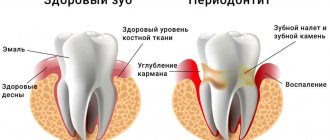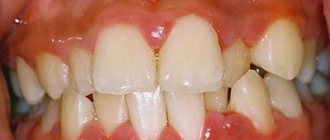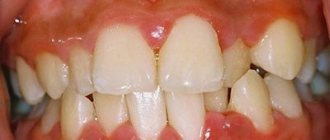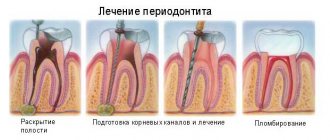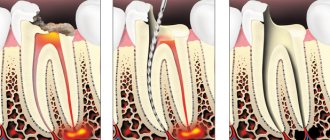Dental periodontitis is an inflammation of an infectious nature that occurs at the membrane of the tooth root and affects the tissues of the oral cavity located next to it. Periodontitis is difficult to confuse with other dental diseases, because it has a clear symptom – severe and constantly increasing pain, which cannot be relieved by taking tablets from the pharmacy.
Treatment of periodontitis must be carried out urgently, because you risk not only losing a tooth, but also acquiring complications that are dangerous to the overall health of the body! How periodontitis occurs, what signs will help to identify the disease in a timely manner, how periodontitis is treated in dentistry, at what prices the service is offered in Moscow - we will talk about this in detail in this article.
Causes of dental periodontitis
Various reasons can lead to the appearance and development of dental periodontitis, but in the vast majority of cases the disease appears:
- Against the background of untreated dental caries and pulpitis;
- Due to poor quality treatment of tooth canals, or more precisely, mistakes made when filling the canals.
Less commonly, periodontitis occurs after injuries, incorrectly installed dental fillings, or violation of the dosage of dental medications.
Whatever the cause of periodontitis, its treatment cannot be delayed due to fear of dentists. It is important to understand that you will not stop the inflammation on your own, with pills or folk remedies, and the more it progresses, the less chance you have of saving the tooth. In addition, periodontitis can also affect neighboring healthy teeth.
How to identify periodontitis and not confuse it with caries or pulpitis? We already talked about the most striking symptom of the disease at the very beginning of the article, but the signs of periodontitis may vary depending on the form of the disease. Therefore, below we will consider the main types of dental periodontitis, as well as talk about their characteristic symptoms.
Take a short test and calculate the cost of treatment!
Take a short test
- Which teeth have caries?
- Visual assessment
- Reaction to stimuli
- Cost calculation
×
Manukyan Artavazd Genrikovich
Chief physician of the clinic
Treatment of chronic periodontitis on teeth
Despite the fact that acute and chronic periodontitis are similar in many ways, treatment of chronic forms of periodontitis is usually more difficult and takes longer than the acute form. Treatment of acute chronic periodontitis is most often carried out using conservative methods and may require endodontic intervention: opening the tooth cavity to drain purulent exudate, filling the canals. Antiseptic drugs and antibiotics are also actively used. In the case of chronic periodontitis, the treatment method depends on the stage of the disease and the presence/absence of complications. Based on this, a conservative or surgical treatment plan is drawn up.
Treatment methods for chronic periodontitis
✔
Conservative treatment of chronic periodontitis. It implies a whole range of measures to eliminate the source of the disease. First of all, the tooth canals are cleaned, antiseptic medications are administered, and anti-inflammatory drugs and antibiotics are taken if necessary. After sanitation, the canals are filled with medicinal filling paste, after which it is necessary to wait for the restoration of periodontal tissue for 1 to 3 months. After this period is completed, a permanent filling is performed. In the treatment process, techniques such as electrophoresis, laser and UHF therapy are often used.
✔
Surgical treatment of chronic periodontitis. Surgical methods for treating chronic periodontitis one way or another involve invasive intervention in periodontal tissue. Typically, this technique is used in advanced stages of periodontitis and when complications develop (cysts, fistulas, etc.). Modern dentistry has a number of surgical techniques that allow you to save part of a root or tooth. These include: tooth root resection (removal of part of the root along with a pathological formation), cystectomy (operation to remove cysts and granulomas), and hemisection (removal of the crown part of a multi-rooted tooth along with the root). Despite the fact that chronic periodontitis of permanent teeth is most often tried to be cured with the help of tooth-preserving manipulations, in the most severe cases complete tooth extraction is indicated.
Signs of acute periodontitis
Symptoms of acute periodontitis are always pronounced. Among them:
- Acute aching pain, the intensity of which is constantly increasing;
- Pain increases when trying to eat;
- If treatment for periodontitis was not started on time, attacks of pain will appear more and more often, and the intervals between them will become shorter and shorter;
Against the background of intense pain, a person cannot eat, speak, sleep, and may develop an elevated temperature. In the acute form of periodontitis, significant tumors and swelling often appear in the area of the diseased tooth. The cheek may also swell. This occurs due to the active accumulation of pus in the soft tissues of the oral cavity.
Rinses
By using antiseptic solutions for mouth rinsing, you can significantly reduce the inflammatory and painful manifestations of periodontitis.
Chlorhexidine
The drug has a strong antimicrobial effect and does not cause irritation to the mucous tissues of the oral cavity. For periodontitis, a 0.05% aqueous solution of chlorhexidine is used. The rinsing procedure should be repeated four times a day until the inflammation subsides.
Dimexide
For periodontitis, dimexide has a pronounced anti-inflammatory effect, relieves pain, has antiseptic activity, and enhances the penetration of other drugs into tissues. Rinse the mouth with a 20% aqueous solution of the drug 3 times a day until symptoms disappear permanently.
Iodine tincture
Iodine preparations penetrate well through tissue to the inflamed area, relieve pain and have an antiseptic effect. To prepare a medicinal solution for rinsing, dissolve 5-6 drops of iodine tincture in a glass of boiled water cooled to 380C. The procedure is repeated 3-4 times a day until pain and other manifestations of the disease are eliminated.
Salt and soda
Rinsing with a solution of soda and salt for periodontitis has analgesic properties and relieves inflammation. With purulent periodontitis, it helps to improve the outflow of pus. Thoroughly dissolve half a teaspoon of baking soda and table salt in 200 ml of warm water and rinse the mouth for two minutes. Such manipulations should be repeated every 2-3 hours. After symptoms subside, you can rinse three times a day.
Symptoms of chronic periodontitis
Chronic periodontitis is a very insidious form of the disease, since it can develop completely asymptomatically. It is extremely rare for a person to feel a slight pain when trying to bite something on a sore tooth; sometimes unpleasant sensations appear when consuming hot food and drinks.
Chronic periodontitis of the tooth is diagnosed with an x-ray, which clearly shows the process of bone destruction at the apex of the tooth root. This form of the disease has its own classification, according to which there are: fibrous, granulating and granulomatous periodontitis. With fibrous periodontitis, there is almost no pain, which is why it is most often recognized either in the acute phase or during an examination by a dentist and x-rays.
Treatment of this form of periodontitis is quite simple and is carried out in 1-2 visits to the doctor. Granulomatous chronic periodontitis most often develops asymptomatically, but under the influence of certain external factors it easily turns into an acute form. The disease has its own characteristic symptom, manifested in the formation of granulomas - capsules with pus, which separate tissues affected by inflammation from healthy ones. The treatment process for granulomatous periodontitis is long and complex, it can last for several months and even require surgical intervention!
The dangers of treating periodontitis at home
The desire of some people to avoid visiting the dental office by any means and continue to endure pain cannot be explained. At the same time, patients persistently practice self-medication, search for recipes on the Internet, rinse their mouths with herbs and smear their sore teeth with homemade compounds of dubious content.
Unfortunately, none of the diseases mentioned in the article can be treated at home. Any method that has been proven over the years, which refers to grandmother’s recipes, will not heal, but will only ease the pain and help the outflow of purulent contents. Remember, the use of this or that non-traditional method of treatment must obtain the approval of a doctor.
Painkillers are also only allowed in limited quantities. Many drugs have a strong and negative effect on the liver and gastrointestinal tract. Therefore, it is unacceptable to constantly relieve pain with pills. And heating a sore tooth, trying to reduce the level of discomfort, is strictly prohibited!
Taking self-prescribed antibiotics will not be successful, because the drug is not able to penetrate into the root canals. It will also not be possible to disinfect and eliminate the source of inflammation by rinsing your mouth. In addition to the warnings voiced, let us remind you that the pathogenic microflora of carious tissues is extremely resistant to drugs, so it cannot be destroyed by taking drugs; drilling is required.
It is better to direct all unspent energy to the prevention of dental diseases. Choosing the right toothbrush, getting into the habit of flossing, and getting regular professional teeth cleanings at your doctor's office are the foundations of oral health.
Treatment of tooth enamel erosion, causes, photos, price
Treatment of pericoronitis of the wisdom tooth in the lower jaw
Retreatment of tooth canals before prosthetics, with granuloma, cyst and aching pain
Root canal treatment for chronic periodontitis
Treatment of dental caries using the Icon method without preparation
Dental treatment without pain in Moscow
Dental treatment without a drill, placing a filling without drilling in Moscow
How does the acute phase of chronic periodontitis manifest?
When exacerbated, chronic periodontitis of the tooth expresses itself with the same symptoms as the acute form of the disease. That is, there is a strong, aching pain, swelling of the gums and swelling of the cheek. Typically, chronic periodontitis enters the acute phase when the immune system is weakened, the flu, ARVI, or simply severe hypothermia are present. If, during an exacerbation of the chronic form, a fistula appears in the gum area, pus will flow from the area of inflammation and the pain in the tooth will gradually subside.
But this does not mean that periodontitis has gone away on its own; the inflammatory process will continue to develop and will manifest itself again under favorable external factors, which we discussed just above. Based on the type of periodontitis, a treatment regimen is selected. The price of the service depends on the regimen chosen for treating the disease. We will tell you below about all the stages of treatment of dental periodontitis in different forms and prices for procedures. But no matter in what form periodontitis develops, its treatment always begins with diagnosis.
Diagnosis of periodontitis involves examination of the oral cavity, x-rays, and examination of patient complaints. All this together helps to accurately diagnose the form of periodontitis and prescribe adequate and effective treatment.
Indications for treatment of periodontitis
There are two main ways to treat periodontitis: conservative and surgical. Each of them has its own indications and contraindications.
According to modern dental standards, a doctor should give preference to conservative methods. They are indicated for both acute and chronic periodontitis, including the appearance of cysts and granulomas, loose teeth, and increasing inflammation.
However, orthograde treatment cannot be used in all cases. Indications for surgical intervention are:
- obstruction of the tooth root canals;
- the presence of a stump tab or pin that cannot be removed without damaging the roots;
- multiple perihilar cysts or cysts growing into the maxillary sinus;
- wide affected area (over 10 millimeters);
- perforation of the tooth cavity or root wall;
- ineffectiveness of conservative treatment methods.
Important!
When we talk about periodontitis, we often mean apical (also known as periapical or apical) periodontitis - that is, inflammation at the apex of the tooth root. The cause of this disease is endodontic problems. Another type of periodontitis, marginal, affects the gums in the cervical area of the tooth, but it already belongs to the field of periodontology. This material is devoted to the treatment of apical periodontitis only.
Repeated treatment of chronic periodontitis
Sometimes specialists have to re-treat chronic periodontitis. This is usually due to the fact that previous treatment was ineffective. This could be poor cleaning and filling of canals, defects during surgical procedures, non-compliance by the patient with rehabilitation rules, as well as an initially incorrectly selected treatment plan. Secondary treatment almost always takes longer and is more difficult. In this case, it is still possible to do without tooth extraction or carry out repeated conservative treatment, however, quite often the patient comes with already developed complications that require surgical intervention.
Therapeutic treatment of periodontitis: features and key stages
Therapeutic treatment of periodontitis is a complex, lengthy process and associated with certain difficulties. In particular, a fairly large amount of time is required to restore periodontal tissues damaged by inflammation; competent and high-quality treatment of dental canals will not be easy.
The complex of therapeutic measures for the treatment of periodontitis includes the following procedures:
- Drilling the diseased tooth to gain access to the canals;
- Work on expanding channels to a certain size, allowing for their high-quality processing;
- Painstaking cleaning of the canals from damaged and destroyed tissues;
- Flushing the canal cavity with antiseptic agents;
- Placement of antibiotic-impregnated linings into the tooth canals;
- Permanent canal filling;
- Restoration of the natural tooth crown.
Treatment of periodontitis may require repeated changes of medications in the canals, and therefore the patient is given a temporary filling for this period. After the inflammatory process can be completely eliminated, the tooth canals are filled with gutta-percha and a permanent photopolymer filling is placed on the tooth.
IMPORTANT: The more stages there are in the therapeutic treatment of periodontitis, the higher the price of the service as a whole will be.
When carrying out filling, it is extremely important to achieve complete sealing of the dental canals and all branches coming from them. After endodontic treatment of periodontitis, the doctor may additionally prescribe a number of medications for the patient to take that will help accelerate tissue recovery. Endodontic treatment of periodontitis can be supplemented by a number of physiotherapeutic procedures:
- UHF;
- Laser and magnetic therapy;
- Ozone therapy.
The need for additional physiotherapeutic procedures is determined by the dentist when drawing up a plan for the therapeutic treatment of periodontitis and based on the diagnostics performed and the characteristics of the clinical case.
